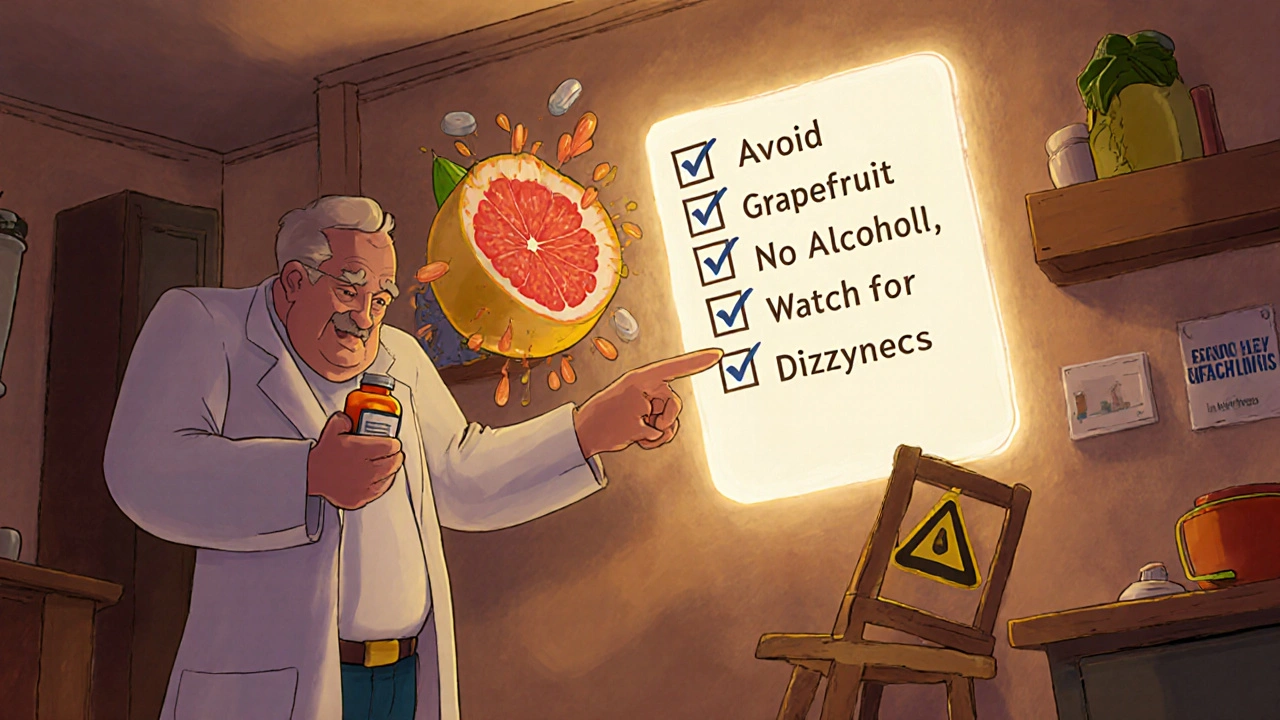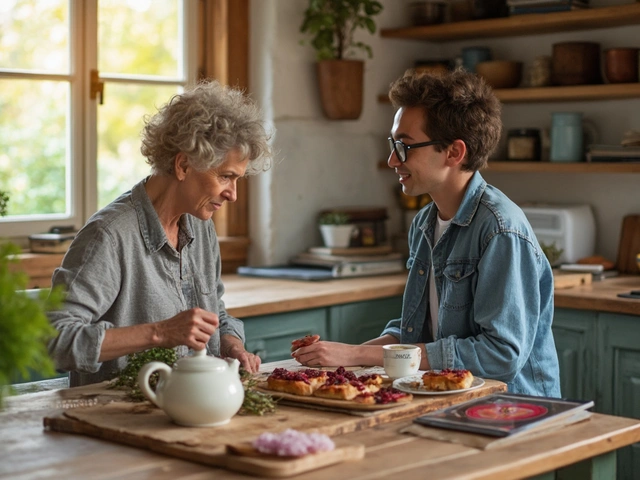
Every time you pick up a prescription, there’s a hidden layer of critical information tucked onto the bottle or in the leaflet. It’s not just the name of the drug or how many pills to take. The safety and warnings sections are there to protect you - and they’re written in a language most people don’t fully understand. If you’ve ever skipped reading them because they looked too technical, you’re not alone. But misunderstanding these warnings can lead to serious harm, even death.
What’s in the Boxed Warning? (The Red Flag)
The most urgent warning on any prescription label is the boxed warning, also called a black box warning. It’s the only part of the label that the U.S. Food and Drug Administration (FDA) requires to be printed with a thick black border. You can’t miss it. And you shouldn’t.This warning appears when a drug has been linked to serious, sometimes life-threatening risks. For example, clozapine - used for severe schizophrenia - carries a boxed warning for agranulocytosis, a condition where your white blood cell count drops dangerously low. Without regular blood tests, this can be fatal. Another example is fluoroquinolone antibiotics like ciprofloxacin, which carry a boxed warning for tendon rupture, especially in people over 60 or those taking steroids.
These aren’t hypothetical risks. According to the FDA, about 400 medications currently have boxed warnings. That’s nearly 9% of all prescription drugs approved since 2000. If your drug has one, it doesn’t mean you can’t take it - but it does mean you need to know exactly why and how it’s being used. Ask your doctor: “What’s the biggest danger here, and how are we preventing it?”
Warnings and Precautions: The Fine Print That Matters
Right after the boxed warning comes the Warnings and Precautions section. This is where the real daily risks live. Unlike the boxed warning, this section isn’t always easy to spot. On pharmacy labels, it’s often buried in small print on the back of the bottle or printed on a separate paper insert.Here’s what to look for:
- “May cause drowsiness” - This isn’t just a suggestion. It means you shouldn’t drive, operate machinery, or make important decisions after taking the drug.
- “Contraindicated with SSRIs” - This means combining this drug with antidepressants like sertraline or fluoxetine could trigger serotonin syndrome, a potentially deadly condition.
- “Use with caution in kidney disease” - Your body may not clear the drug properly, leading to toxic buildup.
These aren’t vague warnings. The FDA requires manufacturers to use precise language like “has been associated with” or “may cause.” If it says “may cause,” that means it’s been documented in clinical trials - not just a rumor. A 2021 study in JAMA Internal Medicine found that only 42% of patients even noticed these warnings on pharmacy bottles. That’s why so many people end up in the ER.
Drug Interactions: When Your Other Pills Turn Dangerous
You’re not taking just one pill. You’re likely taking several. And that’s where things get risky.The Drug Interactions section tells you exactly which other medications, supplements, or even foods can change how your drug works. For example:
- Statin cholesterol drugs like atorvastatin can become dangerously strong if taken with grapefruit juice - increasing the risk of muscle damage.
- Warfarin (a blood thinner) interacts with vitamin K-rich foods like kale and spinach, making your blood clotting unpredictable.
- Some antibiotics can cancel out birth control pills, leading to unintended pregnancy.
Pharmacists are trained to spot these. But they’re busy. A 2022 study found that 73% of patients on five or more medications didn’t realize their prescriptions could clash. The solution? Keep a simple list of everything you take - including over-the-counter pills, vitamins, and herbal teas - and bring it to every appointment. Use apps like Medisafe or MyTherapy to scan your bottles and get real-time alerts about interactions. These tools are 89% accurate when used consistently.

What the Pharmacy Label Doesn’t Tell You
The bottle you get from the pharmacy often has a sticker or printed note that’s meant to be your daily reminder. But here’s the problem: these are usually too small, too vague, or placed where you can’t see them.Look for these common pharmacy warnings:
- “Take on an empty stomach” - This means no food for 2 hours before and after. If you take it with food, the drug may not work.
- “Avoid alcohol” - This isn’t just about getting drunk. Even one drink can intensify dizziness or liver damage with certain drugs.
- “May cause dizziness” - This is a fall risk, especially for older adults. Keep your home well-lit and remove rugs.
California law requires Spanish translations of critical warnings for Spanish-speaking patients. But in most states, there’s no such rule. If you or a family member has limited English, ask the pharmacist for a printed version in your language. Most chains will provide it.
Why People Miss the Warnings - And How to Fix It
Studies show three big reasons people ignore or misunderstand warnings:- They don’t know what “boxed” means. Most patients think it’s just a fancy border - not a red alert.
- They misread timing. “Take 2 hours before meals” is often confused with “take before breakfast.” That’s a big difference.
- They assume it doesn’t apply to them. “I’m healthy - this won’t happen to me.”
Here’s what works:
- Use the “teach-back” method. After the pharmacist explains a warning, say: “So if I take this with grapefruit, I could get muscle pain. Is that right?” If they nod, you got it.
- Create a warning log. Keep a notebook or digital note with each drug, its main warning, and what you need to avoid. One University of Florida study found this improved adherence by 41% in seniors.
- Look for color-coded systems. Some pharmacies now use red for critical, yellow for important, and blue for general. Ask if yours does.

What’s Changing - And What You Should Know
The FDA is making changes. Starting in 2024, all new drug applications must include warning language tested with people who have low health literacy. That means simpler words, clearer instructions, and fewer medical terms.Some pharmacies are testing QR codes on bottles. Scan it, and you’ll get a 60-second video explaining the warning in plain language. Walgreens piloted this with NFC tags and saw warning comprehension jump from 63% to 92%.
But here’s the catch: 24 million Americans have limited digital access. That’s why analog solutions - printed warnings, clear labels, and pharmacist follow-ups - still matter. Don’t wait for technology to fix this. Do it yourself.
Your Action Plan
Here’s what to do the next time you get a prescription:- Find the boxed warning. Look for the black border. If it’s there, read it out loud.
- Check the pharmacy sticker. Is it large enough to read without squinting? If not, ask for a larger version.
- Ask two questions: “What’s the most serious risk I need to watch for?” and “What should I stop doing while taking this?”
- Write it down. Add the warning to your medication log - not just the name, but the risk and how to avoid it.
- Review every 3 months. If you start or stop another drug, go back and check if your warnings changed.
Medication safety isn’t about memorizing every side effect. It’s about knowing the big dangers - and how to avoid them. One warning you understand could prevent a hospital visit. One question you ask could save your life.







I read the boxed warning on my new antidepressant last week, and honestly? I almost cried. I had no idea it could cause serotonin syndrome if mixed with my migraine meds. I called my pharmacist right away-they walked me through it, and we adjusted the timing. I wish everyone knew how much these warnings matter. I’m not exaggerating: this saved me from a hospital trip.
Also, the pharmacy sticker was tiny. I asked for a bigger one. They gave me a laminated card. Best. Decision. Ever.
Wow, so much drama over a pill label. I just swallow mine and hope for the best. My grandma took 17 meds and still danced at my wedding. Maybe we’re overthinking this?
It’s fascinating how the FDA’s regulatory semiotics have evolved to encode risk perception through typographic hegemony-i.e., the black box isn’t merely a visual cue, but a performative act of biopolitical control. The linguistic austerity of ‘may cause’ versus ‘has been associated with’ reveals a deeper epistemological tension between probabilistic causality and clinical certainty.
Moreover, the commodification of patient literacy through QR codes is a neoliberal capitulation to algorithmic paternalism. We’re outsourcing cognition to NFC chips while eroding the hermeneutic capacity of the layperson. 🤔📱
And yet-how many of us have actually *read* the insert? The irony is delicious.
This article is pure fearmongering. You make it sound like every prescription is a death trap. I’ve been on statins for 12 years, drank grapefruit juice every morning, and I’m still alive. Stop scaring people into thinking they need a PhD to take medicine.
Also, who has time to ‘keep a warning log’? I have kids. I work two jobs. You’re not helping-you’re just making people paranoid.
While I appreciate the intent behind this piece, I’m concerned about the implicit assumption that all patients have equal access to healthcare literacy or the time to engage with these materials.
Many elderly patients, non-native speakers, or those with cognitive impairments simply cannot navigate this complexity-even with ‘clearer language.’ The QR code solution, while innovative, excludes millions without smartphones or digital access.
Real change requires systemic investment: trained health navigators in pharmacies, mandatory multilingual inserts, and pharmacist-led counseling-not just ‘ask two questions’ and hope for the best. This isn’t a personal responsibility issue-it’s a public health failure.
Hey, I’m a pharmacist in Texas, and I’ve seen this firsthand. People skip the warnings because they’re overwhelmed. But here’s the thing: most don’t know they can ask for a printed version in Spanish, Tagalog, or even plain English with bigger font.
I had a guy come in last month-he was on warfarin, ate kale every day, and thought ‘vitamin K’ was just ‘healthy stuff.’ We sat down for 15 minutes. He now uses a food tracker app. He’s alive because he asked.
Don’t be shy. Ask. Write it down. Bring a list. We’re here to help-not to judge.
My mom didn’t know the difference between ‘take on empty stomach’ and ‘take before meals.’ She took hers with oatmeal for six months. Nothing happened-but it could’ve.
I printed a simple chart for her: red = stop, yellow = be careful, green = fine. She keeps it taped to her medicine cabinet.
Simple helps.
Coming from India, I’ve seen people take antibiotics with milk because they think it helps digestion. No one reads labels here either. But we have community health workers who go door-to-door with pictorial guides-no words, just pictures of a banana (don’t eat), a glass of water (drink), a bed (rest).
Maybe we need more of that here. Not more jargon. More visuals. More kindness.
I started using Medisafe after my cousin had a bad reaction. It scans the barcode and tells me if something clashes. I didn’t know my fish oil interacted with my blood pressure med.
It’s not perfect-but it’s better than guessing.
Thanks for the reminder to check every 3 months. I’ll do it next week.